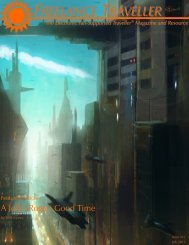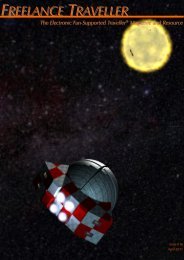Doing It My Way - Freelance Traveller
Doing It My Way - Freelance Traveller
Doing It My Way - Freelance Traveller
Create successful ePaper yourself
Turn your PDF publications into a flip-book with our unique Google optimized e-Paper software.
<strong>Doing</strong> <strong>It</strong> <strong>My</strong> <strong>Way</strong><br />
(Continued from page 20)<br />
fleas are not realized, or at least not until TLs<br />
higher than those found in the Imperium, but by TL<br />
10 and higher, we should assume that any device<br />
that consists largely of advanced electronics can be<br />
made as small as is useful. So, almost any piece of<br />
portable electronics can be made so that it fits conveniently<br />
in the user‘s pocket.<br />
TL 9 Equipment<br />
(Editor‟s Note: <strong>It</strong> is inferred that the TL in the header refers to<br />
when the equipment first becomes available, as the progressive<br />
improvement by TL of each device is discussed.)<br />
Hand Computer (TL 9+): At TL 9, this device<br />
is equivalent to a high end modern smart phone<br />
with touch screen, digital still and video camera,<br />
GPS, limited voice recognition and augmented reality,<br />
including limited image recognition. This device<br />
also contains transceivers capable of connecting<br />
to all Imperial phone and data networks. Hand<br />
computers designed for interstellar travelers also<br />
contain multi-band radios capable of sending and<br />
receiving from similar units with a range of 100 km<br />
and of communicating with the powerful radio<br />
found on a starship at a range of 500 km. This capability<br />
adds nothing to the unit‘s cost. Also, due to<br />
standardized computer protocols, every hand computer<br />
can access basic voice and data services<br />
across the Imperium. At typical TL 9 hand computer<br />
is 12 cm x 6 cm x 9 cm and is either carried<br />
in a pocket or worn on an arm.<br />
At TL 10, the computer used in this device possesses<br />
the High Data command logic and Basic<br />
Command fundamental command program (CT<br />
Book 8: Robots, p. 35) and can understand simple<br />
spoken commands like ―Display all data on Arla<br />
Kasten‘s political career‖ or ―Show me a map of<br />
the fastest route home‖. This computer possesses<br />
limited learning capability and the augmented reality<br />
functions also greatly improve, allowing the<br />
unit to display information on any known object. If<br />
the unit‘s camera is aimed at an animal or plant, it<br />
can provide detailed information about the target<br />
and the device can also perform facial recognition<br />
from any clear visual image. All TL 10 units can<br />
also function as language translators for both writ-<br />
ten and spoken language, as long as the language is<br />
found in Imperial data banks. At TL 10 and higher,<br />
the capacity of a hand computer‘s memory is also<br />
so large that it is unlikely to ever be completely<br />
filled.<br />
At TL 13, all hand computers use holographic<br />
displays instead of flat video screen and their cameras<br />
become holovideo recorders. Advances in<br />
electronic memory mean that the additional storage<br />
requirements of holographic imagery still allow<br />
these devices to have effectively unlimited storage.<br />
This device serves the purpose of a chronometer,<br />
media player, digital still and video camera,<br />
GPS and mapping unit, data network terminal, augmented<br />
reality display, telephone, entertainment<br />
device, and at TL 10+ a language translator.<br />
Cost: Cr 1,000<br />
At TL 13+ the computer in this device can be<br />
made using a limited amount of synaptic circuitry<br />
and possesses the Low Autonomous command<br />
logic and Full Command fundamental command<br />
program, allowing it to understand relatively complex<br />
ordinary speech and make basic inferences.<br />
Cost: Cr 3,000<br />
Rules: At TL 10 the High Data computer in a<br />
hand computer has INT 3 and EDU 2. At TL 13+,<br />
a Low Autonomous computer in a hand computer<br />
has INT 6 and EDU 4 (see CT Book 8: Robots for<br />
details).<br />
TL 10 Equipment<br />
Data Store (TL 10+): This popular device is<br />
designed to contain all of an individual‘s personal<br />
data in an encrypted and secured fashion. Most individuals<br />
keep this storage unit in their hand computer,<br />
interface implant or similar device. However,<br />
others who prefer to interact with their technology<br />
in a less obvious fashion install it in jewelry<br />
or have it implanted, typically between the bones<br />
of their forearm, just above the wrist. If not installed<br />
in a hand computer, a data store communicates<br />
with hand computers and other devices using<br />
short range radio similar to modern Bluetooth.<br />
This radio has a range of approximately 10 meters.<br />
Separate data stores are ovals approximately 1.5<br />
cm x 1 cm x 3 mm.<br />
(Continued on page 22)<br />
21

















